Paris, Sunday, Monday, and Tuesday
posted 05 March 2005
Written 30 March 2005
Sunday morning, we made a leisurely start to the day, then set off for cousin Albert's early, on foot. We strolled from our hotel up the Boulevard St. Michel to the Isle de la Cité. It was Easter Sunday, so we didn't try to get near Notre Dame but instead went via the flower market, which that day was also the bird market. The main bird market is elsewhere, but the canary fanciers were out in force, and canaries of all colors and voices were represented. We looked over the vegetation on offer and selected a handsome potted blue "hortensia" (i.e. hydrangea) as a visiting gift for the Paris Budmans.
The rest of our walk took us over to the right bank and through the Beaubourg district (photo op at the Pompidou Center, the large hamster-habitat-like museum o f modern art) to Albert's place, which is only a couple of blocks from the Hôtel de Ville (City Hall), where we were welcomed by Albert himself, his significant other Claude, their 14-year-old son Samuel, and their black-and-white cat Monsieur Gaston. Their apartment (technically a condo, since Albert's family has owned it for a couple of generations) is a marvel—the half facing the street is two tall floors high and encompasses a vaulted stone cellar (the computer/family room, from which various little stone corridors and stairs lead to a wine cellar, utility space, storage cellar, etc.) below the high-ceilinged living/dining room. The back half is on four levels, which alternate with the two in the front, so that, from the bottom up, you go from the computer room up a couple of steps to a level with Samuel's study and bedroom, then up half a flight to the kitchen, then half a flight to the living room, then half a flight to the master bedroom/loft. It has three bathrooms and is a much more complicated shape than my description conveys. It's filled with antique furniture (especially large armoirs), books, and art, and it's ingeniously designed to rely on line-of-sight privacy— you don't realize until Albert points it out that it's all open-plan. The only door is the one on the WC. They're pretty sure there's another cellar below the one they use (in that district, most buildings had two-story cellars because the land was marshy and you had to dig that deep to find firm ground for the foundations), but they haven't broken through yet to see.
All the Paris Budmans are charming—Albert is an outright character—and Sunday dinner was wonderful. After a round of kirs, we began with cold foie gras, then progressed to the "real" hor d'oeuvres—radishes, superb cherry tomatoes, dry sausage, home-made pickled herring, home-made "tarama" (cod-roe spread), and three kinds of bread. The main course was outstanding "magret de canard"—rare steak of duck—with sautéed potatoes. Then came an assortment of half a dozen excellent cheeses, then a magnificent chocolate ganache cake from the great bakery just next door. Wow.
After lingering over dinner, all of us strolled a couple of blocks over to visit Aunt Frida (Albert's mother) and had a lively bilingual conversation with Aunt Frida herself (now too old and frail to leave her apartment but sharp as a tack otherwise) and Albert's older half-sister, who was visiting at the same time. The upshot is that we're invited back for a predinner drink at Frida's on Friday, before we go out to dinner with Albert and Claude to the restaurant of a friend of theirs!
Written 3 April 2005
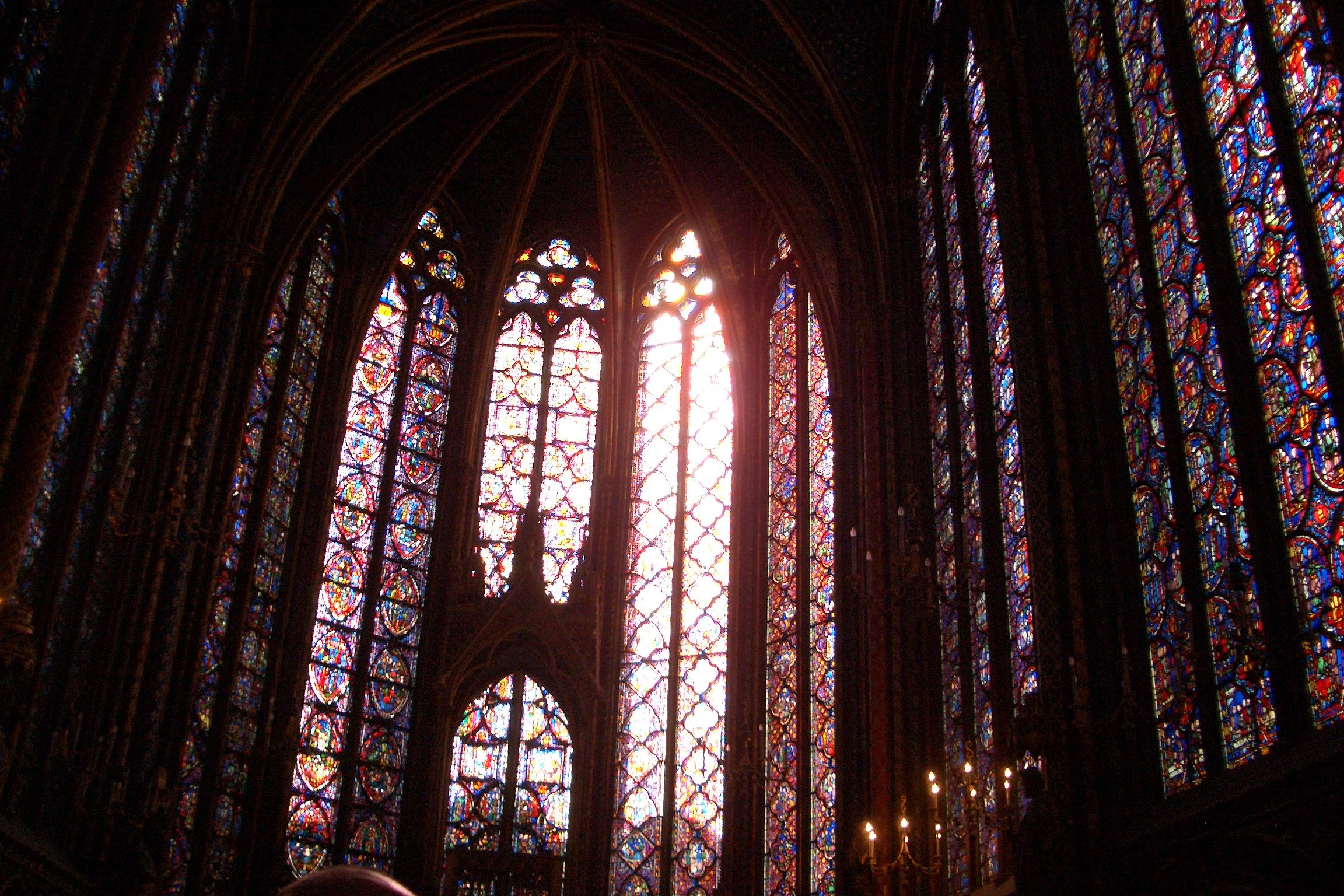 Monday, we walked to the Île de la Cité again, this time to visit the Sainte Chapelle, the high point of gothic architecture, especially with respect to stained glass. I'd say that not more than 20% of the walls are stone. David took this hand-held shot with ambient light. Even though it's rather a small chapel, you can (if you know how) read the entire bible (Old and New Testaments) in its stained glass windows, with enough space left over for the post-Crucifixion history of the Crown of Thorns, which the chapel was intended to house. It must truly have been a wondrous place when it was built—it's darned wondrous even now—but in the meantime, some knucklehead decided to build the Palais de la Justice around it, trapping it inside a closed courtyard and permanently blocking off the sunlight from half the windows! What a dunce!
Monday, we walked to the Île de la Cité again, this time to visit the Sainte Chapelle, the high point of gothic architecture, especially with respect to stained glass. I'd say that not more than 20% of the walls are stone. David took this hand-held shot with ambient light. Even though it's rather a small chapel, you can (if you know how) read the entire bible (Old and New Testaments) in its stained glass windows, with enough space left over for the post-Crucifixion history of the Crown of Thorns, which the chapel was intended to house. It must truly have been a wondrous place when it was built—it's darned wondrous even now—but in the meantime, some knucklehead decided to build the Palais de la Justice around it, trapping it inside a closed courtyard and permanently blocking off the sunlight from half the windows! What a dunce!
Written 5 April 2005
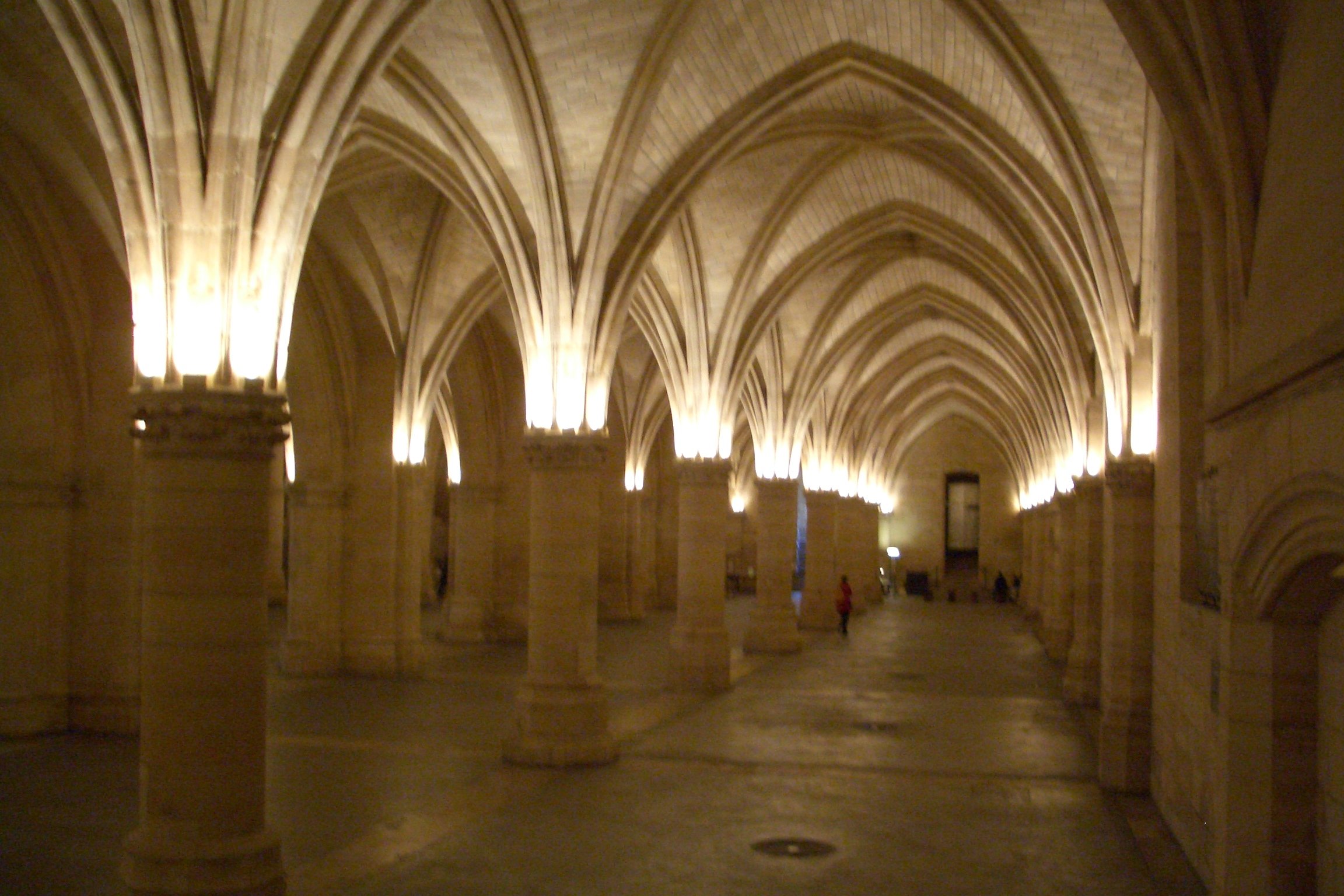 From there, we went next door to visit the Conciergerie, originally the palace housing the Concierge (the king's steward) and his staff (sometimes 2000 people). It's worth seeing for its beautiful architecture—the vast pillared and vaulted guard room, with its four huge fireplaces is one of our favorites—but it's most famous for its later use as a prison. Most of those who went to the guillotine after the revolution spent their last days there, including Marie Antoinette.
From there, we went next door to visit the Conciergerie, originally the palace housing the Concierge (the king's steward) and his staff (sometimes 2000 people). It's worth seeing for its beautiful architecture—the vast pillared and vaulted guard room, with its four huge fireplaces is one of our favorites—but it's most famous for its later use as a prison. Most of those who went to the guillotine after the revolution spent their last days there, including Marie Antoinette.
 Before moving on toward Notre Dame, we applied the hundred-yard rule, souvenir shopping all the way, wound up having lunch in a little "salon de thé" (tea room) on the Quai aux Fleurs (facing the right bank and the Île St. Louis, the other island in the Seine), memorable chiefly for its "crêpitéroles." "Profitéroles" are small cream puffs filled with vanilla ice cream and topped with chocolate sauce. In "crêpitéroles," crêpes replace the cream puffs. As we left, a small group of musicians were playing Sweet Georgia Brown on the pedestrian bridge between the two islands. When they took a break, Michael (from whom Jason inherited his musical talents and interests) introduced himself. It seems they're Americans, and they now live in Paris and make their living playing on the street. You expect that sort of thing in young, struggling musicians, but these guys were our age, and they apparently view the arrangement as entirely satisfactory and intend to carry on indefinitely.
Before moving on toward Notre Dame, we applied the hundred-yard rule, souvenir shopping all the way, wound up having lunch in a little "salon de thé" (tea room) on the Quai aux Fleurs (facing the right bank and the Île St. Louis, the other island in the Seine), memorable chiefly for its "crêpitéroles." "Profitéroles" are small cream puffs filled with vanilla ice cream and topped with chocolate sauce. In "crêpitéroles," crêpes replace the cream puffs. As we left, a small group of musicians were playing Sweet Georgia Brown on the pedestrian bridge between the two islands. When they took a break, Michael (from whom Jason inherited his musical talents and interests) introduced himself. It seems they're Americans, and they now live in Paris and make their living playing on the street. You expect that sort of thing in young, struggling musicians, but these guys were our age, and they apparently view the arrangement as entirely satisfactory and intend to carry on indefinitely.
From our vantage-point on the bridge, we could see that we were most of the way around the island to the holocaust memorial, which closes at dusk, so we visited that next. Rachel and I had been there before, with her daughter Carolyn, but David and the others had never seen it. It's on, or rather in, the extreme eastern point of the Île de la Cité, and on busy days uniformed park personnel are there, two to control the flow of visitors—it's so small that only about a dozen people can fit at a time—and one just to ask each and every visitor to turn off his cell phone and beeper. The memorial is inconspicuous and not well known, so we waited only a few minutes. You enter down a long, narrow stairway to a small, triangular stone courtyard well below ground level but above the water line. To the east, a grilled window looks downriver. To the west, a narrow doorway between granite walls leads into the memorial proper. Inside is a many-angled chamber on the stone walls of which are engraved literary quotations, and through a glass window, you can look into a long, narrow hallway lined with thousands of tiny lights (one for each person deported from France to Germany during the holocaust), flanking the grave of an unknown deportee. Back upstairs, at ground level, is a large plaque listing the classes of people who could be deported to German concentration camps: Jews, homosexuals, Jehovah's Witnesses, dissidents, cripples . . . . There were at least a dozen categories, each with its own arm-band color.
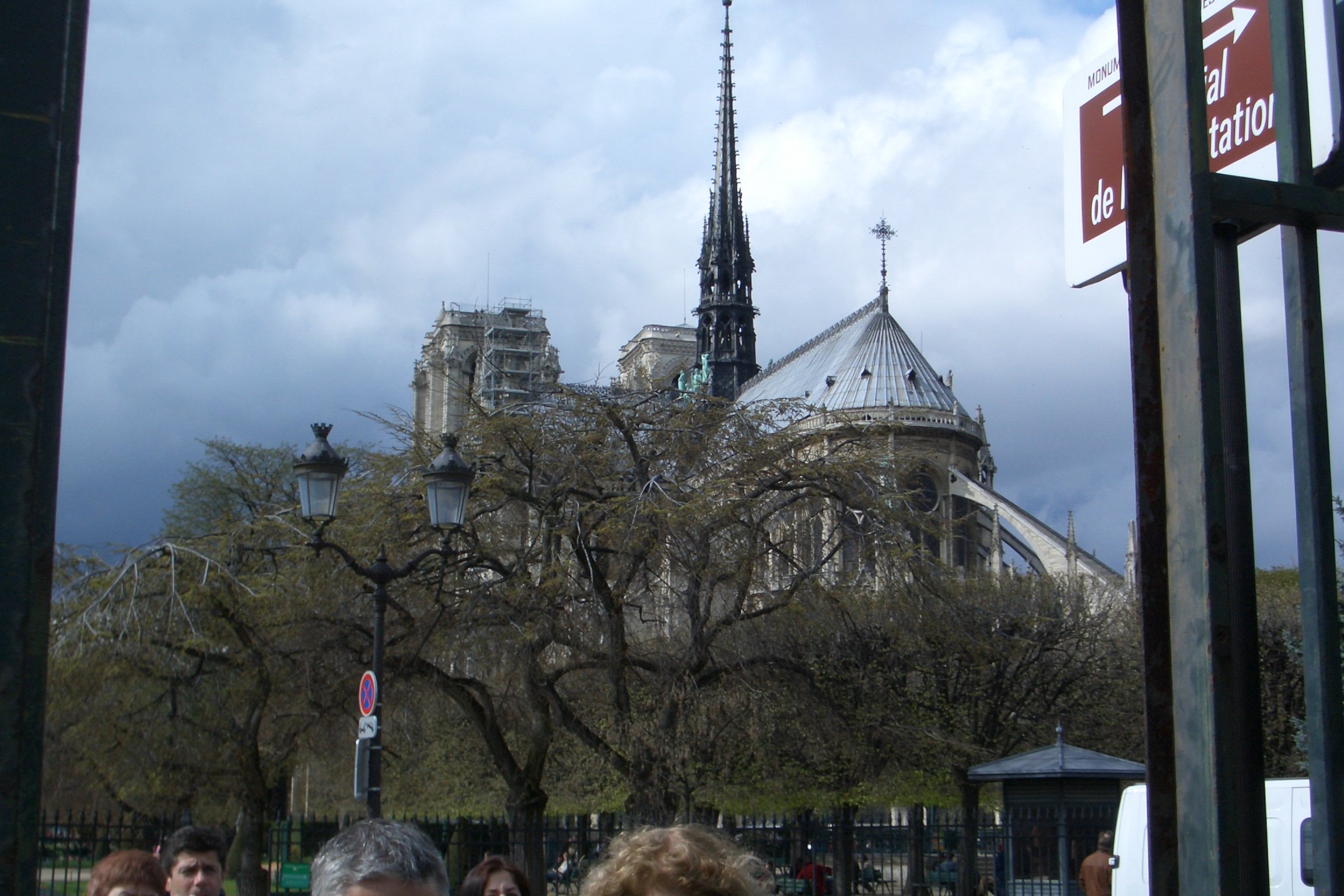 Late in the afternoon, we reached Notre Dame. It was crowded, but much less so than when we were last there, in July a few years ago. Parts of the interior had also been cleaned since our last visit, so it seemed much less dark. For years, the building was black inside and out, but now that Paris's air is cleaner and the exterior has been cleaned, it is largely restored to its original light golden color. I was glad to see that the interior is moving in that direction as well.
Late in the afternoon, we reached Notre Dame. It was crowded, but much less so than when we were last there, in July a few years ago. Parts of the interior had also been cleaned since our last visit, so it seemed much less dark. For years, the building was black inside and out, but now that Paris's air is cleaner and the exterior has been cleaned, it is largely restored to its original light golden color. I was glad to see that the interior is moving in that direction as well.
Tuesday morning, David, the Sinnetts, and I got up early and got a cab to the Place des Pyramides, where we boarded the "Cityrama" bus for a one-day trip to Normandy. )The Budman's elected to stay in Paris to shop and visit the "La Défense" district.) Ev particularly wanted to see the World War II landing beaches, where his father went ashore on D-Day.
The trip from Paris to Caen took three hours, but the bus was a very comfortable one—a doubledecker with large plush seats. During part of the trip, Adrien, our guide lectured in English and Italian about the region we were passing through and about what we would see and do in Normandy.
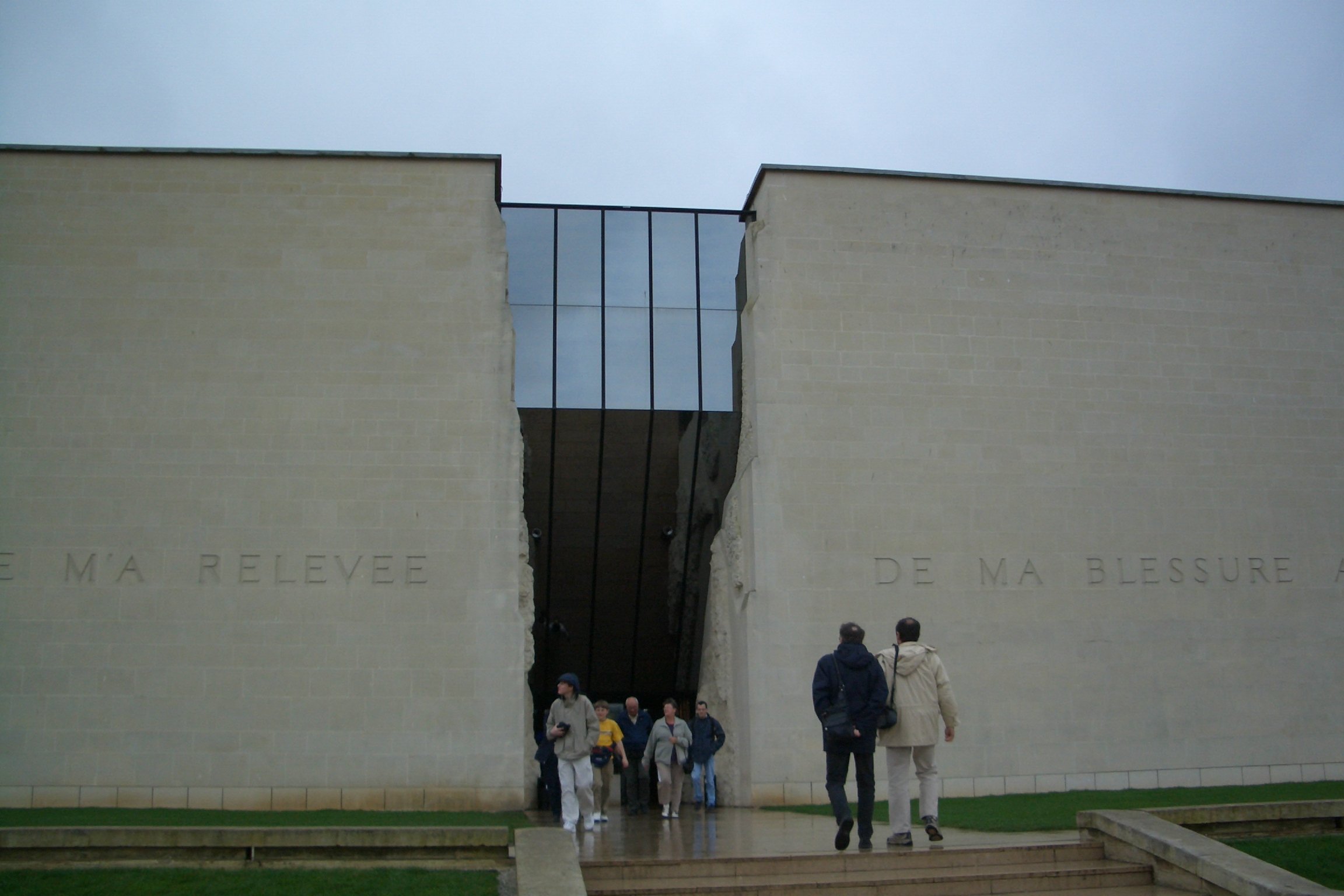 In Caen, we visited the new war memorial and museum—I don't think it was even there when David and I visited Caen four or five years ago—and had about an hour and a quarter to explore the museum (not nearly enough, but what can you do on a one-day tour) before reconvening to view the museum's film—a very effective, almost dialog-free montage of period footage and extremely realistic reenactment. The screen was split, so that footage of the Allied invasion showed on one side while the simultaneous actions of the the German defensive forces showed on the other.
In Caen, we visited the new war memorial and museum—I don't think it was even there when David and I visited Caen four or five years ago—and had about an hour and a quarter to explore the museum (not nearly enough, but what can you do on a one-day tour) before reconvening to view the museum's film—a very effective, almost dialog-free montage of period footage and extremely realistic reenactment. The screen was split, so that footage of the Allied invasion showed on one side while the simultaneous actions of the the German defensive forces showed on the other.
After the film, the 52 members of our group reassembled for lunch. The museum has a regular cafeteria-style restaurant, but they have separate facilities set aside for group tours, so we we ushered into our own dining room, where the tables were set and bottles of wine and water were already in place. We were served plates of chicken breast with an excellent sauce of mushrooms, cream, and Calvados (the apple brandy Normandy is famous for); potatoes; and ratatouille. That course was followed by an all-you-can-eat buffet of cold salads (carrot slaw, pasta salad, celery-root remoulade, lentil salad, etc.), cheeses, and desserts. The île flottant was great.
Written 14 April 2005
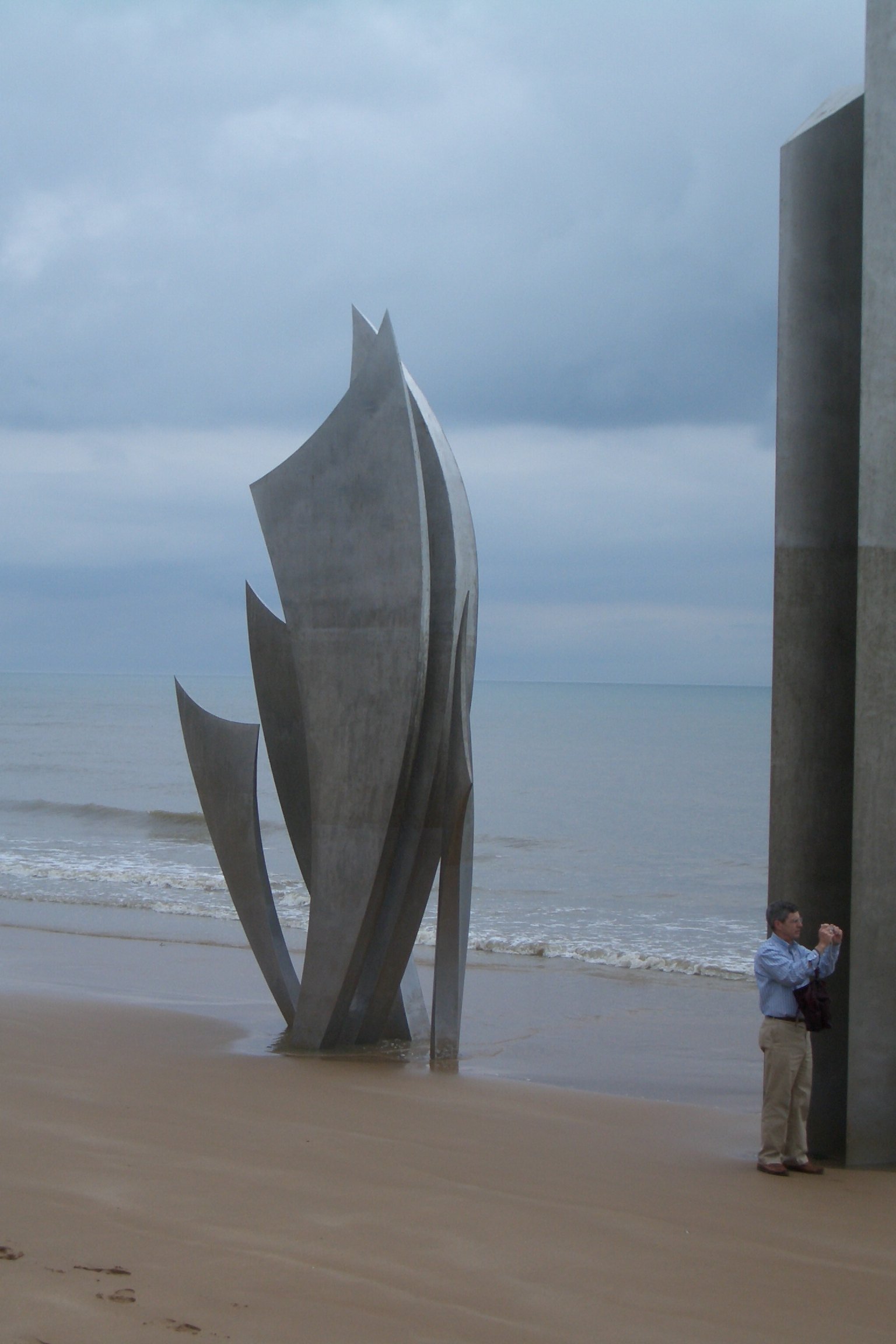 Back in the bus, we set off for the Point du Hoc, the spot on the coast where intreped allied commandos scaled a sheer cliff under fire and suffered extremely high losses to take a crucial battery that turned out to be armed with wooden guns—the Germans didn't have enough fire power, so they armed it with fakes as a deterrent. From there, we worked our way back along the north coast of Normandy, stopping at Omaha Beach (where a new flame-shaped momument has been erected since David's and my last visit), the American cemetery, and Arromanches. The cemetery is particularly moving—David and I remembered it vividly from our previous visit. The grounds are immaculate, and the lawns are mowed with military precision in a criss-cross pattern. At one end is a large semicircular monument on which are engraved two huge maps of the battlegrounds of Normandy. In the center is a tiny chapel containing the emblems of many religions and decorated with modern stained-glass windows depicting different branches of the armed forces. Around the chapel are arrayed, in perfect, slightly curved lines, many thousand pure white Carrera marble crosses, interspersed here and there with stars of David. Each is engraved with the name, rank, home state, and date of death of the soldier buried there; on the back, near the ground is his dog-tag number. Here and there, you come to one that reads "Here rests in honored glory a companion in arms known but to God"; the back is blank. Lt. General Leslie McNair's grave occupies a corner position, but otherwise, we could see no pattern. Officers and enlisted men, Christians and Jews, those who died on the beach on D-Day and those killed weeks later during the campaign all mingle in the rows.
Back in the bus, we set off for the Point du Hoc, the spot on the coast where intreped allied commandos scaled a sheer cliff under fire and suffered extremely high losses to take a crucial battery that turned out to be armed with wooden guns—the Germans didn't have enough fire power, so they armed it with fakes as a deterrent. From there, we worked our way back along the north coast of Normandy, stopping at Omaha Beach (where a new flame-shaped momument has been erected since David's and my last visit), the American cemetery, and Arromanches. The cemetery is particularly moving—David and I remembered it vividly from our previous visit. The grounds are immaculate, and the lawns are mowed with military precision in a criss-cross pattern. At one end is a large semicircular monument on which are engraved two huge maps of the battlegrounds of Normandy. In the center is a tiny chapel containing the emblems of many religions and decorated with modern stained-glass windows depicting different branches of the armed forces. Around the chapel are arrayed, in perfect, slightly curved lines, many thousand pure white Carrera marble crosses, interspersed here and there with stars of David. Each is engraved with the name, rank, home state, and date of death of the soldier buried there; on the back, near the ground is his dog-tag number. Here and there, you come to one that reads "Here rests in honored glory a companion in arms known but to God"; the back is blank. Lt. General Leslie McNair's grave occupies a corner position, but otherwise, we could see no pattern. Officers and enlisted men, Christians and Jews, those who died on the beach on D-Day and those killed weeks later during the campaign all mingle in the rows.
Time was short at each stop, of course. In Arromanches, Rachel and I bought a bottle of 12-year-old Calvados for Michael, who had tasted it for the first time at Albert and Claude's and liked it alot. On the way back to the bus, I spotted a "mésonge bleu" (blue tit, Parus caeruleus). Partway back to Paris, the bus stopped at a large truck-stop, where we could buy sandwiches and salads to eat on the way, and we pulled back into Place des Pyramides about 11 p.m. As we drove past the floodlit Eiffel Tower, it went into "sparkle mode"— every so often, the floodlights go out, and the thousands of white lights mounted on the tower itself flash rapidly on and off in a random pattern, making the whole tower twinkle and sparkle all over. Like a watched pot, it never does it when you wait; it always happens when you least expect it.
previous entry List of Entries next entry
 Monday, we walked to the Île de la Cité again, this time to visit the Sainte Chapelle, the high point of gothic architecture, especially with respect to stained glass. I'd say that not more than 20% of the walls are stone. David took this hand-held shot with ambient light. Even though it's rather a small chapel, you can (if you know how) read the entire bible (Old and New Testaments) in its stained glass windows, with enough space left over for the post-Crucifixion history of the Crown of Thorns, which the chapel was intended to house. It must truly have been a wondrous place when it was built—it's darned wondrous even now—but in the meantime, some knucklehead decided to build the Palais de la Justice around it, trapping it inside a closed courtyard and permanently blocking off the sunlight from half the windows! What a dunce!
Monday, we walked to the Île de la Cité again, this time to visit the Sainte Chapelle, the high point of gothic architecture, especially with respect to stained glass. I'd say that not more than 20% of the walls are stone. David took this hand-held shot with ambient light. Even though it's rather a small chapel, you can (if you know how) read the entire bible (Old and New Testaments) in its stained glass windows, with enough space left over for the post-Crucifixion history of the Crown of Thorns, which the chapel was intended to house. It must truly have been a wondrous place when it was built—it's darned wondrous even now—but in the meantime, some knucklehead decided to build the Palais de la Justice around it, trapping it inside a closed courtyard and permanently blocking off the sunlight from half the windows! What a dunce! From there, we went next door to visit the Conciergerie, originally the palace housing the Concierge (the king's steward) and his staff (sometimes 2000 people). It's worth seeing for its beautiful architecture—the vast pillared and vaulted guard room, with its four huge fireplaces is one of our favorites—but it's most famous for its later use as a prison. Most of those who went to the guillotine after the revolution spent their last days there, including Marie Antoinette.
From there, we went next door to visit the Conciergerie, originally the palace housing the Concierge (the king's steward) and his staff (sometimes 2000 people). It's worth seeing for its beautiful architecture—the vast pillared and vaulted guard room, with its four huge fireplaces is one of our favorites—but it's most famous for its later use as a prison. Most of those who went to the guillotine after the revolution spent their last days there, including Marie Antoinette. Before moving on toward Notre Dame, we applied the hundred-yard rule, souvenir shopping all the way, wound up having lunch in a little "salon de thé" (tea room) on the Quai aux Fleurs (facing the right bank and the Île St. Louis, the other island in the Seine), memorable chiefly for its "crêpitéroles." "Profitéroles" are small cream puffs filled with vanilla ice cream and topped with chocolate sauce. In "crêpitéroles," crêpes replace the cream puffs. As we left, a small group of musicians were playing Sweet Georgia Brown on the pedestrian bridge between the two islands. When they took a break, Michael (from whom Jason inherited his musical talents and interests) introduced himself. It seems they're Americans, and they now live in Paris and make their living playing on the street. You expect that sort of thing in young, struggling musicians, but these guys were our age, and they apparently view the arrangement as entirely satisfactory and intend to carry on indefinitely.
Before moving on toward Notre Dame, we applied the hundred-yard rule, souvenir shopping all the way, wound up having lunch in a little "salon de thé" (tea room) on the Quai aux Fleurs (facing the right bank and the Île St. Louis, the other island in the Seine), memorable chiefly for its "crêpitéroles." "Profitéroles" are small cream puffs filled with vanilla ice cream and topped with chocolate sauce. In "crêpitéroles," crêpes replace the cream puffs. As we left, a small group of musicians were playing Sweet Georgia Brown on the pedestrian bridge between the two islands. When they took a break, Michael (from whom Jason inherited his musical talents and interests) introduced himself. It seems they're Americans, and they now live in Paris and make their living playing on the street. You expect that sort of thing in young, struggling musicians, but these guys were our age, and they apparently view the arrangement as entirely satisfactory and intend to carry on indefinitely. Late in the afternoon, we reached Notre Dame. It was crowded, but much less so than when we were last there, in July a few years ago. Parts of the interior had also been cleaned since our last visit, so it seemed much less dark. For years, the building was black inside and out, but now that Paris's air is cleaner and the exterior has been cleaned, it is largely restored to its original light golden color. I was glad to see that the interior is moving in that direction as well.
Late in the afternoon, we reached Notre Dame. It was crowded, but much less so than when we were last there, in July a few years ago. Parts of the interior had also been cleaned since our last visit, so it seemed much less dark. For years, the building was black inside and out, but now that Paris's air is cleaner and the exterior has been cleaned, it is largely restored to its original light golden color. I was glad to see that the interior is moving in that direction as well. In Caen, we visited the new war memorial and museum—I don't think it was even there when David and I visited Caen four or five years ago—and had about an hour and a quarter to explore the museum (not nearly enough, but what can you do on a one-day tour) before reconvening to view the museum's film—a very effective, almost dialog-free montage of period footage and extremely realistic reenactment. The screen was split, so that footage of the Allied invasion showed on one side while the simultaneous actions of the the German defensive forces showed on the other.
In Caen, we visited the new war memorial and museum—I don't think it was even there when David and I visited Caen four or five years ago—and had about an hour and a quarter to explore the museum (not nearly enough, but what can you do on a one-day tour) before reconvening to view the museum's film—a very effective, almost dialog-free montage of period footage and extremely realistic reenactment. The screen was split, so that footage of the Allied invasion showed on one side while the simultaneous actions of the the German defensive forces showed on the other. Back in the bus, we set off for the Point du Hoc, the spot on the coast where intreped allied commandos scaled a sheer cliff under fire and suffered extremely high losses to take a crucial battery that turned out to be armed with wooden guns—the Germans didn't have enough fire power, so they armed it with fakes as a deterrent. From there, we worked our way back along the north coast of Normandy, stopping at Omaha Beach (where a new flame-shaped momument has been erected since David's and my last visit), the American cemetery, and Arromanches. The cemetery is particularly moving—David and I remembered it vividly from our previous visit. The grounds are immaculate, and the lawns are mowed with military precision in a criss-cross pattern. At one end is a large semicircular monument on which are engraved two huge maps of the battlegrounds of Normandy. In the center is a tiny chapel containing the emblems of many religions and decorated with modern stained-glass windows depicting different branches of the armed forces. Around the chapel are arrayed, in perfect, slightly curved lines, many thousand pure white Carrera marble crosses, interspersed here and there with stars of David. Each is engraved with the name, rank, home state, and date of death of the soldier buried there; on the back, near the ground is his dog-tag number. Here and there, you come to one that reads "Here rests in honored glory a companion in arms known but to God"; the back is blank. Lt. General Leslie McNair's grave occupies a corner position, but otherwise, we could see no pattern. Officers and enlisted men, Christians and Jews, those who died on the beach on D-Day and those killed weeks later during the campaign all mingle in the rows.
Back in the bus, we set off for the Point du Hoc, the spot on the coast where intreped allied commandos scaled a sheer cliff under fire and suffered extremely high losses to take a crucial battery that turned out to be armed with wooden guns—the Germans didn't have enough fire power, so they armed it with fakes as a deterrent. From there, we worked our way back along the north coast of Normandy, stopping at Omaha Beach (where a new flame-shaped momument has been erected since David's and my last visit), the American cemetery, and Arromanches. The cemetery is particularly moving—David and I remembered it vividly from our previous visit. The grounds are immaculate, and the lawns are mowed with military precision in a criss-cross pattern. At one end is a large semicircular monument on which are engraved two huge maps of the battlegrounds of Normandy. In the center is a tiny chapel containing the emblems of many religions and decorated with modern stained-glass windows depicting different branches of the armed forces. Around the chapel are arrayed, in perfect, slightly curved lines, many thousand pure white Carrera marble crosses, interspersed here and there with stars of David. Each is engraved with the name, rank, home state, and date of death of the soldier buried there; on the back, near the ground is his dog-tag number. Here and there, you come to one that reads "Here rests in honored glory a companion in arms known but to God"; the back is blank. Lt. General Leslie McNair's grave occupies a corner position, but otherwise, we could see no pattern. Officers and enlisted men, Christians and Jews, those who died on the beach on D-Day and those killed weeks later during the campaign all mingle in the rows.